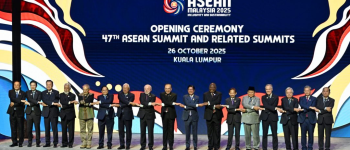75 years of India- China Relations
29th Jul 2025
Read

TABLE OF CONTENTS
- What is the historical timeline of India-China relations?
India and China are not just neighbour's; they are two of the oldest civilizations in the world, and today, two of the most influential Asian powers. Over the last 75 years, their relationship has moved through phases of friendship, conflict, cooperation, and competition. As we mark 75 years of diplomatic relations in 2025, the India-China equation remains one of the most complex bilateral ties—rich in history but fraught with modern-day geopolitical and strategic challenges.
What is the historical timeline of India-China relations?
Ancient and Pre-Modern Contacts
• Long before modern diplomacy, India and China were connected through trade, religion, and philosophy.
• The spread of Buddhism from India to China around the 1st century AD played a significant role in shaping cultural bonds.
• Chinese monks like Fa Xian and Xuan Zang visited India for learning, while Indian monks like Bodhidharma travelled to China.
During the Colonial Period
• Both nations were under pressure from Western powers, which led to a sense of shared struggle.
• Indian personalities like Rabindranath Tagore visited China (1924), advocating Asian unity.
• India also sent medical missions during the Sino-Japanese war in the 1930s, including the famous Dr. Kotnis.
Post-Independence Era • 1950: India was among the first countries to recognize the People's Republic of China.
• 1954: The famous Panchsheel Agreement promoted peaceful coexistence.
• 1962: Relations broke down after the India-China War over border disputes in Aksai Chin and Arunachal Pradesh.
• 1976: Full diplomatic relations were resumed after a 15-year gap.
• 2005-2020: Economic relations boomed, but strategic mistrust persisted, especially after incidents like Doklam (2017) and Galwan Valley clash (2020).
What are the recent developments in India-China relations?
In the last year or two, some positive developments have taken place:
• High-Level Meetings: Prime Minister Modi and President Xi met at the BRICS Summit in Kazan (2024), marking a diplomatic reset.
• Border Management: Both sides agreed to resume patrolling and grazing activities in parts of Eastern Ladakh—an important step toward reducing tensions.
• Religious Connect: After five years, India resumed the Kailash Mansarovar Yatra, a culturally significant move.
• Shared View on Terrorism: the BRICS Joint Declaration issued following the summit meeting in Brazil condemned a terrorist attack in Jammu & Kashmir—something China had earlier avoided, signalling growing understanding.
• Investment Policy Reforms: Recently, India's NITI Aayog recommended easing investment restrictions for Chinese firms, allowing up to a 24% stake in Indian companies without prior government approval.
However, some issues remain unresolved such as:
• No direct flights between the two countries,
• Concerns about business visas, and
• Lack of cooperation on water data sharing, especially for rivers that flow into India.
Why Stable India-China Relations Matter?
1. Border Peace- Without peace on the border, economic development and regional cooperation become difficult.
2. Regional and Indo-Pacific Stability- With both countries playing significant roles in the Indo-Pacific, their ability to manage tensions affects the wider geopolitical balance.
3. Economic Interdependence
• Bilateral trade has reached $118.4 billion (2023-24).
• India relies on China for APIs (pharma), electronics, and solar modules.
• China is a key investor in India's startup ecosystem.
4. Access to Critical Resources- China dominates the rare earths market, which is vital for India's electric vehicle and green energy goals.
5. Global Governance Influence- Cooperation in BRICS, SCO, G20, and AIIB allows both nations to influence global policies from an Asian perspective.
What are the Key Challenges in India-China Relations?
1. Unresolved Borders
• India shares a 3,488-km undemarcated border with China across five states.
• Incidents at Doklam, Galwan, and Tawang show that mutual distrust remains high.
• The Line of Actual Control (LAC) is still not clearly defined.
2. Trade Deficit
• India's trade deficit with China stands at $85 billion.
• China limits India's access to certain high-tech exports, including rare earths and tunnel boring machines.
3. China-Pakistan Strategic Ties
• The China-Pakistan Economic Corridor (CPEC) runs through Pakistan-occupied Kashmir (PoK), violating India's sovereignty.
• Deep military and nuclear cooperation between China and Pakistan complicates India's strategic calculations.
4. China's Assertive Regional Role
• China's increasing involvement in South Asia—Sri Lanka, Maldives, Nepal—is viewed with suspicion.
• Its activities in the South China Sea and rejection of the Quad (India, US, Japan, Australia) adds to tensions.
5. Water Disputes
• China controls transboundary rivers like the Brahmaputra.
• Construction of dams and lack of hydrological data sharing raises fears of water being used as a strategic weapon.
What should be the way Forward?
1. Diplomatic Engagement- Continue dialogue through multilateral forums like BRICS, SCO, and G20 to keep channels open.
2. Mutual Respect- While China seeks India's commitment to the One China Policy, it should also respect India's concerns over terrorism and territorial integrity.
3. Balanced Strategy
• India should maintain its strategic autonomy—cooperate where possible but stand firm on sovereignty.
• Strengthen alliances like the Quad to counterbalance China's influence.
4. Water Cooperation- Set up joint mechanisms for river data sharing and flood management to prevent future disputes.
5. Confidence-Building Measures (CBMs)- Go beyond military CBMs—promote cultural exchanges, trade delegations, academic ties, and media presence in both countries.
Conclusion
In his book The India Way: Strategies for an Uncertain World, India's External Affairs Minister Dr. S. Jaishankar writes, “Managing China is about realism, agility, and strategic clarity.” This statement encapsulates the core challenge India faces in dealing with its powerful neighbour.
India must engage with China without any illusions—balancing diplomacy with deterrence, cooperation with caution, and principles with pragmatism. Despite enduring differences, fostering a stable and respectful relationship between these two Asian giants is not just desirable, but essential—for ensuring regional peace, contributing to global stability, and supporting the evolution of a multipolar world order.
Feel free to use images in our website by simply providing a source link to the page they are taken from.
-- Epoch IAS
Explore By Category
Latest Posts
Share views on 75 years of India- China Relations
Please keep your views respectful and not include any anchors, promotional content or obscene words in them. Such comments will be definitely removed and your IP be blocked for future purpose.
 9th Aug 2025
9th Aug 2025
 30th Oct 2025
30th Oct 2025
.png) 8th Aug 2025
8th Aug 2025
 31st Oct 2025
31st Oct 2025
 27th Aug 2025
27th Aug 2025
 29th Jul 2025
29th Jul 2025
 29th Jul 2025
29th Jul 2025
 29th Oct 2025
29th Oct 2025
